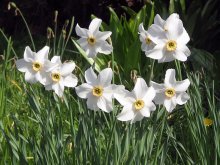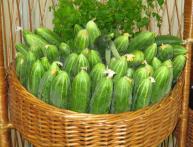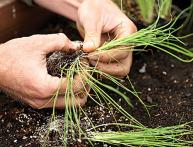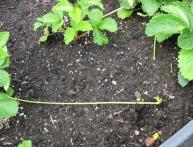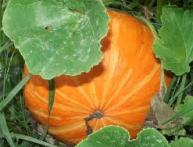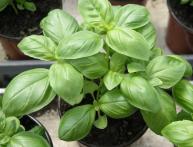Types, description, planting of some bulbous spring flowers
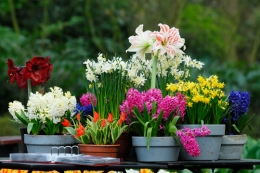
Only in a fairy tale is it possible to find the first flowers under the snow in December. In real life, autumn and winter last so long in many regions that many gardeners want their garden to bloom on the first warm days, even if soil Not all the snow has melted yet. Bulbous spring flowers will help make this wish come true. Let's try to understand these plants, find out which of them will bloom the very first, and which will delight you with flowering a little later.
Content:
- Which plants are spring bulbous flowers?
- How to grow early flowering small bulbous plants in the garden
- Planting spring bulbous flowers with large bulbs
Which plants are spring bulbous flowers?
Spring bulbous flowers can be divided into two groups according to the size of the bulb:
- small-bulbous, bulbs with a diameter of 2.0 - 2.5 cm
- large-bulbous, bulbs larger than 3.0 cm
Flowers with small bulbs differ in their flowering time, some of them bloom very early. Depending on the weather conditions, their beautiful inflorescences can be seen as soon as the snow melts from the area. Early flowering small bulbous plants are the first to awaken. This is due to the characteristics of the bulbs. They need significantly less time to wake up. They begin to grow earlier, devoting all their strength to forcing the peduncle and forming flowers.As a rule, these are low plants with flowers, most often bell-shaped, collected in inflorescences of various shapes, white, yellow, pink or blue. These include:
- galanthus, white bell flowers, flowering time occurs in the last ten days of March - the first ten days of April
- spring whiteflower, differs from galanthus in the shape of the flower and the presence of yellow spots on it
- Chionodoxa, with white, lilac, blue flowers
- Erythronium americana, bright yellow flowers
- Pushkinia, white flowers with blue stripes
- scylla, flower petals are bent back, blue flowers
- muscari, flowers are often blue or purple, but there are varieties with white and pink inflorescences
Large-bulbous spring flowers begin to bloom in the second half of April and they bloom for quite a long time. Their flowers are also pleasing to the eye at the beginning of summer, especially if the spring was late and cold; these include the following bulbous flowers:
- hyacinths
- daffodils
- tulips
- imperial hazel grouse
- decorative bows
All spring bulbous flowers are quite hardy and unpretentious, however, there are certain agricultural techniques, the knowledge of which will help to grow bright and beautiful plants on the site.
How to grow early flowering small bulbous plants in the garden
Almost all spring flowers with small bulbs are propagated by both seeds and daughter bulbs. When propagated by seed, plants bloom within a few years. This method is suitable mainly for plants that very rarely produce daughter bulbs. After flowering and seed ripening, a dormant period begins. In most cases, the bulb is dug up, if necessary, the daughter bulbs are separated and stored until autumn. In the fall, they need to be planted before the soil freezes.When purchasing small bulbs of any type of flower, you should choose strong ones, without rot or damage, and preferably without heavily grown roots.

Spring whiteflower
Bulbous perennial The spring whiteflower plant is able to open its flowers very early. Shoots appear almost immediately from under the snow. They are low, up to 20 cm, with peduncles reaching a height of 30 cm, with narrow leaves, no wider than 1.5 - 2.0 cm. On the peduncle the flowers are single or paired, white, with yellow or greenish spots on the petals. The flowers are drooping, about 3 cm in size, and have a delicate, pleasant aroma. The flowering period is about 15 days.
When planting, you need to choose a place with very moist, but drained and fertile soil. It is best to choose areas with light shade, near natural or artificial reservoirs. If the plant is planted for the first time, it is best to do it with bulbs. At the end of September, add well-rotted manure and peat to the garden bed. They should not be brought in fresh.
In warm autumn weather, planting time is pushed back to the end of October. The bulb is planted to two depths of its size. If the soil is heavy, then it is enough to plant it no deeper than 1-1.5 sizes. The top of the planting can be mulched with a layer of peat.
With high-quality planting material in the spring, white flowers will delight you with early and abundant flowering. After a snowy winter, additional watering is not required, but if there was no snow, then the plant needs watering. The plant also responds well to the application of potassium and phosphorus fertilizers. As a disadvantage, the tendency to self-seeding should be noted.
Scylla or Scilla
These plants are distinguished by their original flower shape. The thin petals of the scilla are bent back.The petals at the stem are almost white, and towards the tops their color changes from light blue to dark blue. The advantage of these colors is their absolute unpretentiousness. They grow equally well in full sun, in partial shade, and even in significant shade.
Those plants that are planted in good light will bloom two weeks earlier than those that are placed in the shade. It is important to remember that, despite its unpretentiousness, Scylla does not tolerate acidic soil and stagnant moisture. Before planting, it is advisable to add several buckets of forest soil to the garden bed. Planting scylla bulbs is no different from planting whiteflower bulbs. When propagated by seed, the seeds are sown in the ground in the spring, but such scylla will bloom only after five years.
Planting spring bulbous flowers with large bulbs
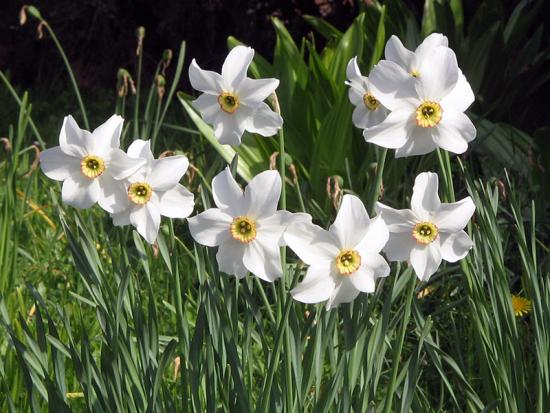
Spring bulbous flowers, regardless of the size of the bulbs, retain their qualities throughout the entire growing period; they do not degenerate or deteriorate in their qualities. Large bulbs store more nutrients than small ones. They are stronger, better resistant to drying out or rotting, and easier to store. In addition, botanical tulips, crocuses, and daffodils can be dug up once every 5 to 6 years.
Bulbs of varietal or hybrid plants are dug up annually after the above-ground parts die off. In the fall, most often in October, they are planted in a prepared bed. Large bulbous flowers bloom at the end of April. Their flowering can take place not only in May, but also in the first half of June.
Daffodils
These flowers have been covered in legends among many peoples since ancient times. Currently, mainly hybrid forms are used in gardening. daffodils. It is noteworthy that they all have double flowers, consisting of a crown and a perianth.The classic combination is a yellow root and white petals around it. Nowadays there are a variety of color combinations. There are completely yellow, white daffodils, some with double bracts, with bright orange crowns. To plant daffodils, it is best to use bulbs rather than seeds.
When choosing a location, you need to know that daffodils are less demanding of sunlight and soil than tulips. They can be planted both on turf and under trees.
They grow in any fertile soil, but you should still avoid planting them on highly alkaline and swampy lands. The best planting time is mid-September. They dig up the bed, add rotted manure and sand. If the bulbs are dug up annually, then they are planted to a depth of 5 cm; if they are left in the ground for 3 years, then the depth should be about 20 cm. When industrially planted for cutting, daffodils are planted in rows; just for landscaping, they can be planted in small groups.
In spring, daffodils are fed with potassium-nitrogen mixtures. As soon as flowering ends and the above-ground parts begin to dry, the bulb must be dug up, otherwise it will begin to take root again. In addition, spring bulbous plants bloom well in open ground; you can leave a few bulbs in the fall and plant them for forcing to get beautiful flowers by the desired date.
Video about bulbous flowers in the garden and their cultivation:


